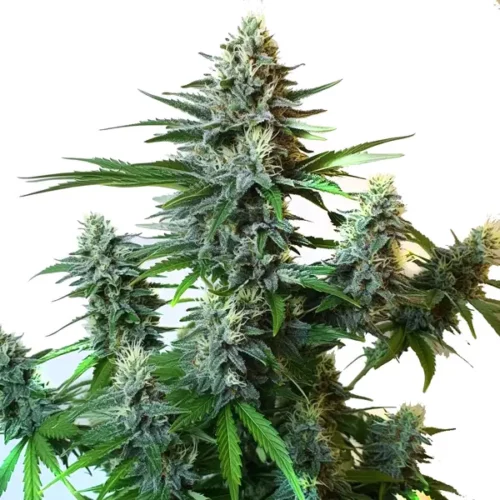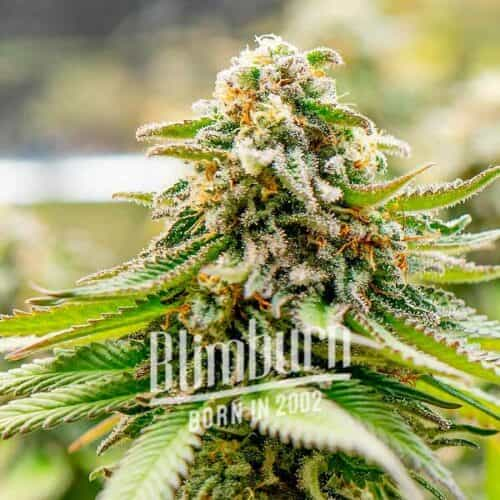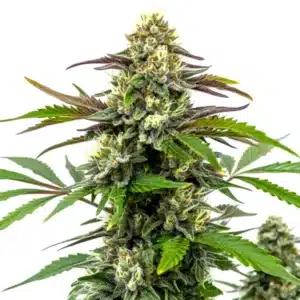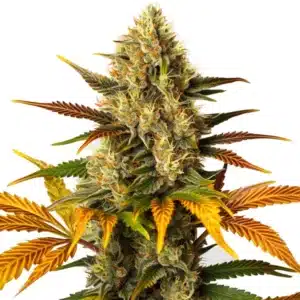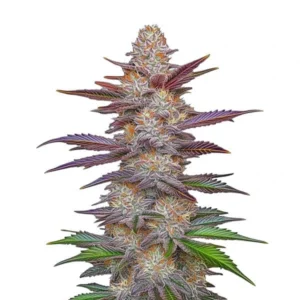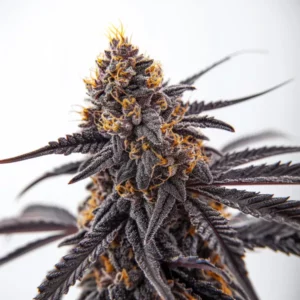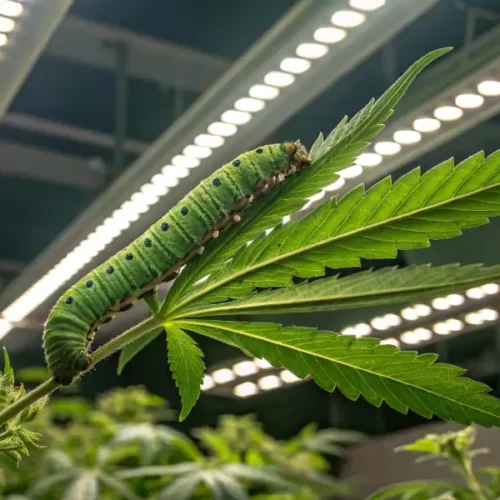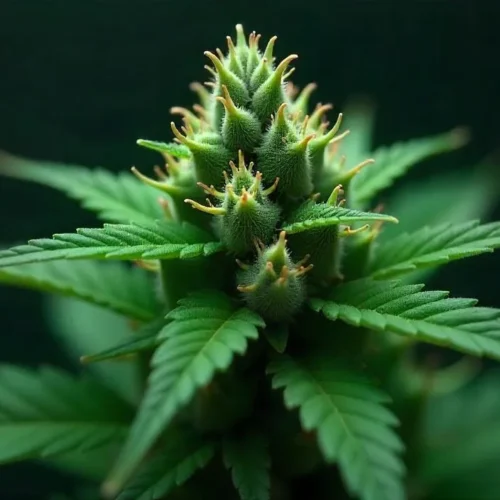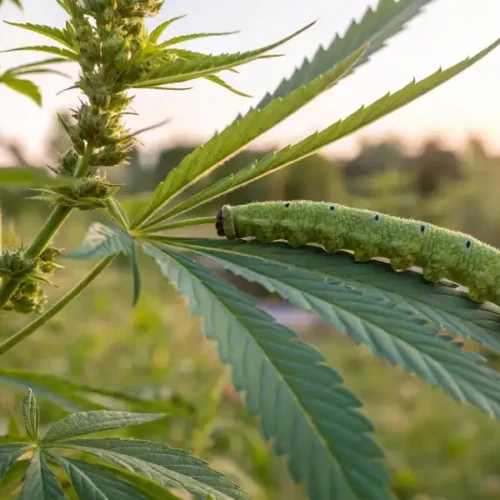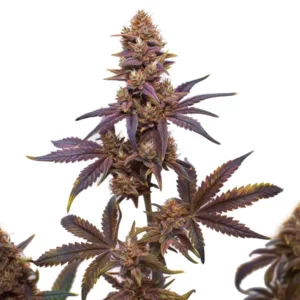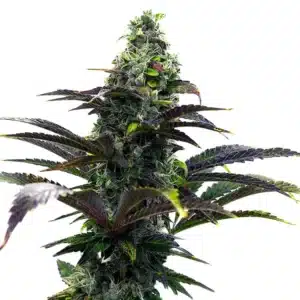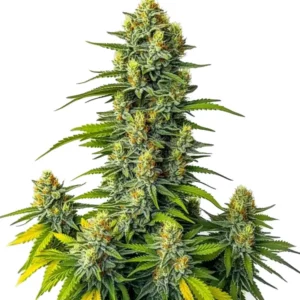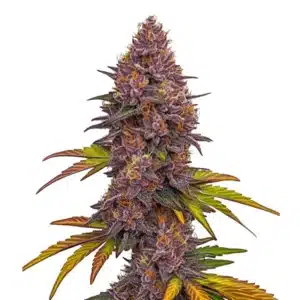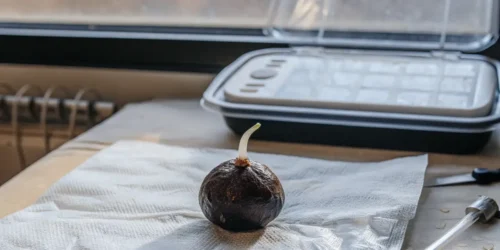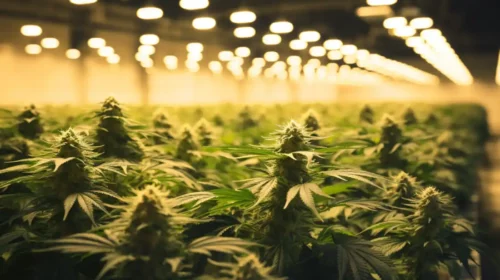GG Autoflower F1 Description
GG Auto F1, a descendant of the legendary Gorilla Glue genetics, is a potent and versatile cannabis strain that has captured the attention of growers and users alike. This strain is known for its exceptional resin production, which gives the buds a frosty, sticky appearance. With a high THC content of around 20-25%, it provides a powerful, balanced high that combines cerebral stimulation with a relaxing body effect. This strain is popular among both recreational and medicinal users for its potent effects and easy cultivation process.
As an autoflowering strain, GG Autoflower F1 does not depend on light cycles to transition from the vegetative stage to flowering. This feature makes it an excellent choice for beginner growers or those looking to harvest multiple times a year. The plant typically produces dense, medium-sized buds that are covered in a thick layer of trichomes, emitting a pungent aroma that blends earthy pine with subtle notes of sour lemon and diesel.
Recommended Strains
Gorilla Glue Autoflower F1
 THC: 24% - 28%
THC: 24% - 28% Type of seed: Autoflower F1
Type of seed: Autoflower F1 Phenotype: Mostly Sativa
Phenotype: Mostly Sativa Day to flower: 8 - 10 weeks
Day to flower: 8 - 10 weeks
Gorilla Glue #4 x Zkittlez
 THC: 20% - 24%
THC: 20% - 24% Type of seed: Feminized
Type of seed: Feminized Phenotype: Mostly Indica
Phenotype: Mostly Indica Day to flower: 8 - 10 weeks
Day to flower: 8 - 10 weeks
The flavor profile of this strain mirrors its aroma, offering a rich, full-bodied taste that lingers on the palate. The strain’s terpenes, primarily myrcene, caryophyllene, and limonene, contribute to its unique scent and flavor as well as its potential therapeutic benefits, including relief from stress, pain, and insomnia. Whether you’re a seasoned grower or just starting, this strain offers a robust, resilient strain that delivers high-quality results with minimal fuss.
Promos & Deals
Environmental Requirements for Growing GG Auto F1
Creating the perfect environment for this strain is crucial to maximize its growth potential and yield. The specific needs of this autoflowering strain will help you cultivate a healthy and productive garden, whether indoors or outdoors.
It thrives in a stable environment with consistent temperatures ranging between 68-77°F (20-25°C) during the day and slightly cooler at night. As one of the best sativa autoflower strains, it is resilient to slight variations in temperature and humidity, but maintaining stability is key for optimal growth and resin production. The ideal humidity level during the vegetative phase is around 60%, which should be gradually reduced to 40-50% as the plant enters the flowering stage to prevent mold and mildew formation on the dense buds.
When growing this strain indoors, proper lighting is essential. High-quality LED grow lights are recommended for their energy efficiency and ability to provide the full spectrum of light that cannabis plants need. A light cycle of 18-20 hours of light per day is ideal during both the vegetative and flowering phases, as autoflowers do not rely on darkness to initiate flowering. For outdoor cultivation, choose a location that receives plenty of sunlight and has well-draining soil to support robust growth and development.
In regions with shorter growing seasons or less reliable weather, consider using a greenhouse to extend the growing period and protect your plants from adverse conditions. This strains to varying climates makes it a versatile choice for growers in different regions, but ensuring a stable environment will result in the highest yields and best-quality buds.
Setting Up The Growing Space for GG Autoflower F1
Setting up an efficient and organized growing space is vital for the successful cultivation of this strain. Whether you are growing indoors or outdoors, proper preparation will enhance plant health and maximize yield potential.
Indoor Cannabis Cultivation
For indoor cultivation, selecting the right grow tent or space is critical. Your setup should allow enough vertical space for the plants to grow and enough room for air circulation to prevent mold and mildew. Install an exhaust fan with a carbon filter to control odor and maintain air quality. Reflective materials like Mylar can help maximize light distribution, ensuring that every part of the plant receives adequate light exposure.
The choice of growing medium is also important. It can thrive in various mediums, including high-quality soil, coco coir, or hydroponic systems. Ensure that the medium you choose allows for good drainage to prevent waterlogging, which can lead to root rot. Additionally, maintaining a balanced pH level of 6.0-6.5 is crucial for nutrient absorption. Indoor growers should also invest in a reliable pH meter to monitor soil or water levels regularly.
Outdoor Cannabis Cultivation
When cultivating this strain outdoors, it’s essential to choose a site that provides ample sunlight throughout the day. This strain prefers well-draining soil rich in organic matter to support robust root development. Consider using large containers or fabric pots to control the growing environment better and prevent overwatering or nutrient runoff.
To protect your plants from strong winds or unexpected weather changes, place them near a natural barrier such as a fence or hedge. Using stakes or trellises to support the branches will help prevent them from breaking under the weight of the heavy, resinous buds. Outdoor growers should also be mindful of pests and take preventive measures such as applying organic insecticides or introducing beneficial insects to keep their crops healthy and pest-free.
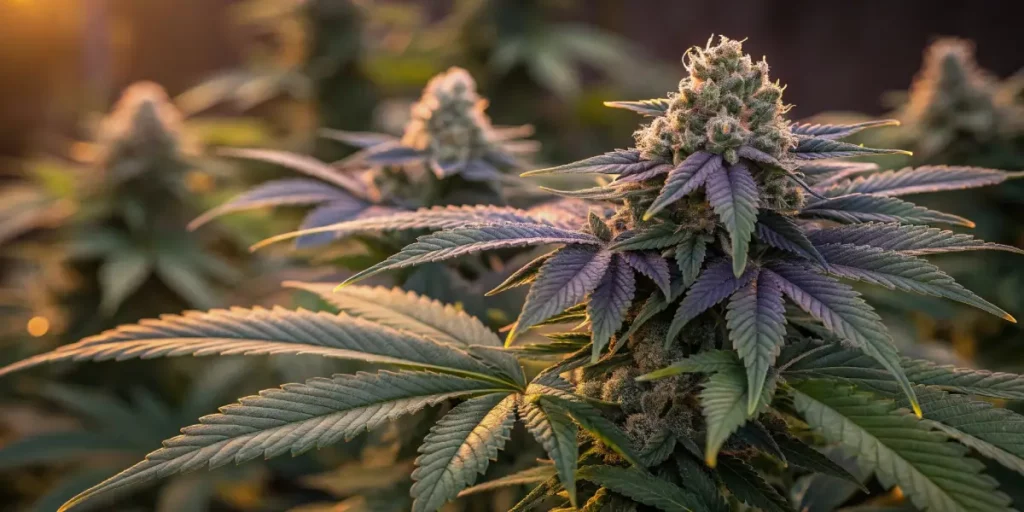
Propagation and Germination of GG Autoflower F1
Successful germination and propagation of this strain are crucial steps in ensuring robust plant development. Here’s how to achieve a high germination rate and set your plants up for success:
- Select Quality Seeds: Start with high-quality GG Autoflower F1 seeds from a reputable seed bank to ensure genetic stability and consistency as Blimburn.
- Germination Process: Soak the seeds in distilled water or place them in a damp paper towel for 24-48 hours. Maintain a temperature between 70-85°F and keep the environment dark and undisturbed to encourage sprouting.
- Planting Seedlings Directly: Once the seeds have sprouted and developed small taproots, plant them directly into their final growing container. Use a pot with a minimum size of 2 gallons (7 liters) to give the plant enough space for optimal growth. This will avoid the need for transplanting later, which can stress autoflowering plants.
- Early Growth Environment: Keep the seedlings in a warm and humid environment with gentle airflow, maintaining a temperature around 75-80°F and humidity levels of 60-70% for optimal germination and early growth.
- Gradual Light Exposure: Increasing the light intensity as the seedlings develop. Avoid exposing young plants to intense light or heat, which can cause stress or damage.
Vegetative Phase
The vegetative phase is crucial for establishing a solid foundation for your plants. During this period, the focus should be on promoting healthy growth and preparing the plants for flowering.
Lighting: For optimal vegetative growth, provide your plants with 18-20 hours of light per day. LED grow lights are an excellent choice as they offer the full spectrum needed for photosynthesis and are energy-efficient. Ensure that the lights are positioned at an appropriate distance to prevent light burn while maximizing coverage.
Nutrition: During this stage, your plants will require a balanced nutrient mix with a higher nitrogen content to support robust leaf and stem growth. Use a high-quality cannabis fertilizer and follow the manufacturer’s guidelines to avoid overfeeding, which can lead to nutrient burn and other issues.
Watering: Consistent watering practices are key to preventing stress and promoting healthy root development. Water your plants when the top inch of the soil feels dry, but avoid waterlogging, which can cause root rot. Consider using a moisture meter to monitor soil conditions accurately.
Training: Techniques such as low-stress training (LST) and topping can be used during the vegetative phase to shape your plants and improve light penetration. These methods help create an even canopy, promoting better bud development and potentially increasing yields.
Pruning: Regular pruning of lower branches and leaves that receive little light will help improve airflow within the canopy and reduce the risk of mold and pests. Prune with care to avoid removing too much foliage, which can stress the plants.
By focusing on these aspects during the vegetative phase, you’ll set your plants up for a successful flowering period and a bountiful harvest.
Flowering Phase of GG Auto F1
The flowering phase is the most exciting part of growing this strain, as this is when the plants develop their resinous, aromatic buds. Here’s what you need to know to optimize this critical stage:
Lighting: Since it is an autoflowering strain, it does not rely on a change in light cycles to begin flowering. Maintaining a consistent light schedule of 18-20 hours per day throughout its life cycle is recommended for optimal growth and bud development. Ensure your grow lights provide ample coverage and are positioned at a distance that maximizes light exposure without causing heat stress or light burn to the upper canopy.
Nutrition: During the flowering phase, shift your nutrient regimen to a bloom-specific formula higher in phosphorus and potassium to support bud development and resin production. These nutrients are essential for healthy flower formation and enhancing the plant’s terpene profile. Be cautious with nutrient levels, as autoflowers can be sensitive to overfeeding, leading to nutrient burn and reduced yields.
Temperature and Humidity: As the plants transition into flowering, adjust the environment to slightly lower temperatures, ideally between 65-75°F (18-24°C), to stimulate resin production and prevent heat stress. Humidity levels should be kept around 40-50% to reduce the risk of mold or bud rot, especially given the density of this buds. Good air circulation is crucial to maintaining these conditions and ensuring robust growth.
Support: The weight of the dense, sticky buds can cause branches to bend or break as GG Autoflower F1 matures. Providing support through stakes, cages, or trellises can help prevent damage and ensure that the plant maintains its structure under the weight of the developing buds.
Flowering Time: This strain typically has a flowering time of around 8-10 weeks from germination, depending on the growing conditions and phenotype. Monitoring trichome development using a magnifying tool is essential to determine the optimal harvest window. Look for milky white trichomes with some amber hues to ensure the best cannabinoid and terpene profile for harvest.
Throughout the flowering stage, remain vigilant for any signs of pests or diseases. The dense bud structure of this strain makes it susceptible to mold and pests if not properly managed. Regularly inspect your plants and maintain a clean growing environment to minimize these risks.
Cannabis Fertilization and Nutrition
Proper nutrition is a cornerstone of successful cannabis cultivation, particularly with a strain like this. To maximize the potential of your plants, knowing their nutritional needs throughout their lifecycle is essential.
Choosing the Right Fertilizer: Begin with a high-quality cannabis-specific fertilizer that provides a balanced mix of macronutrients (nitrogen, phosphorus, potassium) and micronutrients (calcium, magnesium, sulfur, iron, etc.). During the vegetative stage, a higher nitrogen formula will promote vigorous leaf and stem growth. As the plant transitions to the flowering phase, shift to a bloom formula with higher phosphorus and potassium to support bud development and resin production.
Feeding Schedule: Follow a structured feeding schedule tailored to the growth stage of your plants. Start with a lower concentration of nutrients and gradually increase as the plants grow and show signs of needing more. Overfeeding can lead to nutrient burn, characterized by yellowing or browning leaf tips, while underfeeding can stunt growth and reduce yields. Regularly monitoring your plants and adjusting the nutrient levels as needed is crucial for maintaining optimal health.
Supplements and Additives: Consider incorporating additional supplements to enhance plant growth and development. During the vegetative phase, beneficial microbes and mycorrhizal fungi can improve nutrient uptake and root health. As the plants flower, adding bloom boosters rich in phosphorus and potassium can enhance bud size and potency. Products containing humic and fulvic acids may also improve nutrient absorption and overall plant vigor.
Flushing your plants with pure water during the final two weeks before harvest can help remove any excess salts and nutrients, resulting in a cleaner, smoother final product. This practice can prevent harsh flavors and ensure the full expression of the strain’s terpene profile.
Pest and Disease Control for Growing Cannabis
Even resilient strains like this can fall victim to pests and diseases if not properly managed. Implementing a comprehensive pest and disease control strategy is essential to protect your plants and ensure a healthy harvest.
Prevention:
- Regularly inspect your plants for signs of pests such as spider mites, aphids, or thrips. Early detection is key to preventing infestations from spreading.
- Maintain a clean growing space by removing dead plant material, debris, and potential breeding grounds for pests and pathogens.
- Introduce beneficial insects like ladybugs or predatory mites to help control pest populations naturally. These insects can help keep harmful pests in check without the use of chemical pesticides.
- Ensure proper airflow and ventilation to reduce humidity levels and prevent mold and mildew formation, particularly during the flowering phase.
- Quarantine new plants or clones before introducing them into your grow area to prevent the spread of pests or diseases.
Corrective Actions:
- If you detect pests, use organic or low-toxicity pest control products designed specifically for cannabis. Neem oil, insecticidal soaps, and horticultural oils can be effective against common pests.
- For fungal diseases like powdery mildew or botrytis, remove infected plant material, increase airflow, and apply organic fungicides or natural remedies such as potassium bicarbonate or milk spray solutions.
- In cases of severe infestations or persistent diseases, consult with a professional grower or horticulturist to develop a targeted treatment plan.
Harvesting and Curing for Cannabis Growing
Harvesting GG Autoflower F1 at the right time and properly curing the buds are essential steps to ensure the best quality of your final product. These steps will help preserve the strain’s aroma, flavor, and potency.
Trichome Maturity: Use a magnifying glass or microscope to closely examine the trichomes on your buds. Harvest when most trichomes are milky with a few turning amber. This balance indicates peak potency, ensuring a robust profile of cannabinoids and terpenes.
Harvesting: Carefully cut the branches one by one using sterilized pruning shears. Avoid touching the buds excessively to preserve their resin content. Remove any large fan leaves but leave smaller sugar leaves intact, as they protect the buds during the drying process.
Drying: Hang the harvested branches upside down in a dark, well-ventilated space with temperatures between 60-70°F (15-21°C) and humidity around 50-60%. Proper airflow is crucial to prevent mold and mildew while allowing the buds to dry evenly. This process typically takes 7-14 days, depending on environmental conditions.
Curing: Once the buds are dried, carefully trim them from the branches and place them in airtight glass jars. Store the jars in a cool, dark place with a stable temperature and humidity (58-62%). Open the jars daily during the first week to allow moisture to escape, gradually reducing the frequency to once every few days. The curing process can take 2-4 weeks or longer, enhancing flavor, aroma, and potency.
Proper harvesting and curing are essential to producing high-quality buds. Patience during these final stages will ensure that your hard work results in a top-shelf product.
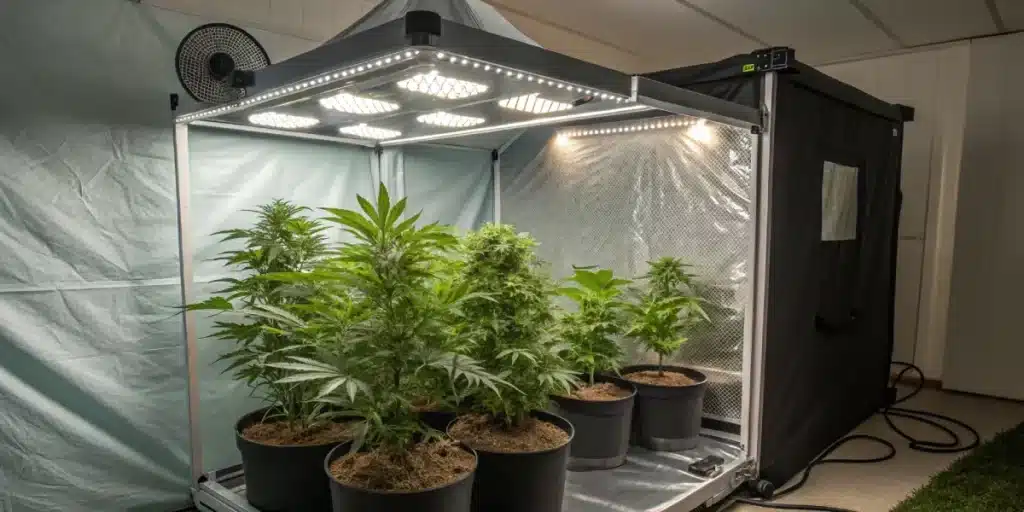
Is GG Autoflower F1 Indica or Sativa?
This strain is a hybrid cannabis strain that offers a balanced blend of Indica and Sativa characteristics. While the strain’s exact ratio can vary slightly depending on the specific phenotype, this strain typically leans towards a balanced or slightly Indica-dominant hybrid.
The Indica genetics contribute to the strain’s potent body effects, providing deep relaxation and relief from physical discomfort, making it a popular choice for evening use or those seeking stress relief and muscle relaxation. Meanwhile, the Sativa side of this strain offers uplifting cerebral effects, promoting creativity, focus, and a sense of euphoria. This combination of effects has contributed to the strain’s popularity and versatility among cannabis enthusiasts.
Whether you’re looking for a strain to unwind after a long day or one to spark creative inspiration, it offers a well-rounded effect that caters to a wide range of preferences.
Advantages of Growing GG Autoflower F1
Growing GG Autoflower F1 presents several advantages that make it a great choice for cannabis cultivators, whether you are a novice or an experienced grower:
- Rapid Growth Cycle: As an autoflowering strain, it grows quickly, allowing for multiple harvests in a single season. This is particularly advantageous for growers looking to maximize their yield in a limited amount of time.
- High THC Content: This strain boasts a high THC content, typically ranging from 20% to 25%. This makes it a potent strain that delivers a powerful, well-rounded high, appealing to both recreational and medicinal users.
- Resilient and Easy to Grow: This strain is highly resilient to environmental stresses and common pests, making it an excellent choice for beginner growers. Its autoflowering nature also reduces the need for strict light schedules, simplifying the cultivation process.
- Adaptability to Various Growing Environments: It is versatile and can be successfully grown both indoors and outdoors. It is well-suited to different climates and can thrive in a variety of growing mediums, from soil to hydroponic systems.
- Compact Size: The strain’s compact size makes it ideal for growers with limited space. Despite its smaller stature, GG Autoflower F1 is capable of producing substantial yields of dense, resinous buds.
- Distinct Aroma and Flavor Profile: With its rich terpene profile, it offers a unique aroma and flavor that combines earthy pine with hints of sour lemon and diesel. This distinctive profile adds to its appeal for both connoisseurs and casual users alike.
- Balanced Effects: The hybrid nature of this strain provides a balanced high that combines the relaxing body effects typical of Indica strains with the uplifting cerebral stimulation associated with Sativa strains. This balance makes it versatile for various occasions and uses.
Disadvantages
While it offers many benefits, there are a few potential disadvantages to consider when choosing this strain for cultivation:
- Moderate Yields: Although it is known for its potency, the yields may not be as high as those of some other strains. However, its rapid growth cycle can offset this by allowing for more frequent harvests.
- High Odor During Flowering: This strain can produce a strong and pungent odor, especially during the flowering phase. Indoor growers may need to invest in odor control measures, such as carbon filters, to manage the scent.
- Sensitivity to Nutrient Levels: Like many autoflowering strains, it can be sensitive to nutrient levels. Overfeeding can lead to nutrient burn, which may affect the overall health and yield of the plants. It’s important to carefully monitor and adjust nutrient levels to avoid any issues.
- Limited Control Over Vegetative Time: Due to its autoflowering genetics, growers have limited control over the length of the vegetative phase. This can be a disadvantage for those looking to optimize plant size and yield through extended vegetative growth.
Despite these potential drawbacks, it remains a popular choice for many growers due to its ease of cultivation, potency, and unique characteristics.
Why Buy GG Auto F1
There are several compelling reasons to consider purchasing GG Autoflower F1 for your next cultivation project:
- 1. Potency and Effectiveness: With its high THC content, it offers a potent high that is both cerebral and physically relaxing, catering to a wide range of user preferences.
- 2. Easy Cultivation: The strain’s autoflowering nature and resilience make it an excellent choice for novice growers. It requires less maintenance and attention to light schedules, simplifying the cultivation process.
- 3. Versatile Growing Conditions: It can be grown in a variety of environments, whether indoors, outdoors, or in a greenhouse. Its adaptability makes it a flexible choice for different climates and setups.
- 4. Quick Turnaround: The rapid growth cycle of this strain allows for multiple harvests in a year, providing a quick return on investment and a steady supply of high-quality cannabis.
- 5. Unique Flavor and Aroma: The strain’s distinctive flavor and aroma profile, featuring earthy, piney notes with a hint of citrus, makes it a favorite among cannabis enthusiasts looking for a unique sensory experience.
When purchasing this strain, ensure you buy from reputable sources to guarantee the quality and authenticity of the genetics. This will help ensure a successful cultivation experience and a satisfying final product.
Common Problems When Growing GG Autoflower F1
While it is generally easy to grow, there are a few common issues that growers should be aware of to ensure a healthy and productive crop:
1. Nutrient Sensitivity: Autoflowering strains like this can be more sensitive to nutrient levels compared to photoperiod strains. Overfeeding can lead to nutrient burn, while underfeeding may result in nutrient deficiencies. It is essential to monitor your plants closely and adjust feeding schedules as needed to maintain balanced nutrition.
2. Mold and Mildew: Due to the dense structure of the buds, it is susceptible to mold and mildew, especially in high humidity environments. Ensuring proper air circulation and maintaining a lower humidity level during the flowering phase can help mitigate this risk.
3. Pests: Like all cannabis plants, GG Autoflower F1 is vulnerable to common pests such as spider mites, aphids, and thrips. Regular inspections and preventive measures, such as introducing beneficial insects or using organic pest control products, are crucial to keeping your plants pest-free.
4. Environmental Stress: Autoflowering strains can be more sensitive to environmental stressors, such as sudden changes in temperature, humidity, or light intensity. Keeping a stable growing environment and minimizing stress can help your plants thrive.
By being aware of these potential problems and taking proactive steps to address them, you can ensure a successful cultivation experience with this strain.
Similar Strains
If you enjoy this strain, you might also be interested in these similar strains:
- Blue Dream Autoflower: A well-balanced hybrid that combines the best of both Indica and Sativa, Blue Dream Autoflower offers uplifting effects and a sweet, berry flavor. It’s a great strain for daytime use and can be grown both indoors and outdoors.
- Critical Purple Autoflower: Known for its relaxing effects and high THC levels, Critical Purple Autoflower is perfect for unwinding after a long day. The strain is dense, resinous buds with a sweet, earthy aroma and is suitable for both novice and experienced growers.
FAQs
How long does it take for GG Autoflower F1 to grow?
This strain typically takes about 8-10 weeks from seed to harvest. This rapid growth cycle makes it a great choice for growers looking for a quick turnaround.
What is the THC content of GG Autoflower F1?
This strain usually has a THC content ranging from 20% to 25%, making it a potent strain that delivers strong effects.
Can GG Autoflower F1 be grown outdoors?
Yes, it can be grown both indoors and outdoors. It is a versatile strain that adapts well to different environments and climates.
Is GG Autoflower F1 suitable for beginners?
Absolutely! It is a great strain for beginners due to its resilience, autoflowering nature, and ease of cultivation.
What are the effects of GG Autoflower F1?
It offers a balanced high, combining cerebral stimulation with relaxing body effects. It’s suitable for both recreational and medicinal use.

